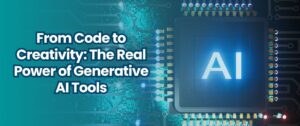A Beginner’s Guide to Creating Custom Generative AI Models

What is Generative AI?
Understanding the Concept in Simple Terms
Generative AI is like teaching a computer to create something new — whether that’s writing an article, drawing a picture, composing music, or even designing clothes. It works by learning from large amounts of existing data, such as thousands of articles or images, and then uses that knowledge to generate fresh, original content.

Unlike traditional AI, which mostly analyzes or predicts, generative AI builds. It’s like the difference between someone who reads books and someone who writes them. Tools like ChatGPT, DALL·E, and Midjourney are all powered by generative AI. The idea is to give machines a sense of creativity — one that’s built on real-world patterns.
Start with a Clear Purpose
Know What You Want to Build Before You Begin
The first thing you should do before jumping in is to define your goal. Ask yourself: What do I want my AI model to do? Are you interested in generating blog posts, helping users chat with bots, or maybe designing AI-generated artwork?
Having a clear purpose keeps you focused. If you just start building without knowing your goal, you’ll likely get overwhelmed. So, start small. For example, try building a simple AI that writes poems or generates product descriptions. Once you’re confident, you can explore more complex ideas.
Choose the Right Tools for the Job
Frameworks and Platforms That Help Beginners
You don’t have to build everything from scratch. Today, there are plenty of tools and platforms that make the process easier — especially for beginners.
If you’re working with text, Hugging Face is a great place to find pre-trained models. For more general projects, TensorFlow (by Google) and PyTorch (by Meta/Facebook) are the most popular frameworks. They offer tons of tutorials and community support.
Not sure where to run your code? Use platforms like Google Colab or Kaggle — they let you train models for free using cloud GPUs. You just need a Google account and some basic Python skills to get started.
Find and Prepare Your Data
Your AI Can Only Learn What You Teach It
Think of data as food for your AI model. If you feed it junk, it won’t perform well. If you feed it quality information, it will learn better and create smarter content.
Depending on your project, you might need text data (like articles), image data (like photos or drawings), or even sound files. You can find free datasets on websites like Kaggle or through open-source communities. Once you have your data, it needs cleaning. That means removing errors, duplicates, or anything irrelevant.
Good data = good results. Don’t skip this step.
Train Your AI Model
Teaching the Model Step by Step
Training a model is where the magic happens. Here, you feed your cleaned data into the model and let it learn. This can take time depending on how much data you have and what kind of model you’re using.
You’ll need to adjust things like how fast the model learns (learning rate), how much data it processes at a time (batch size), and how many times it repeats the learning cycle (epochs). These are called hyperparameters, and tweaking them helps improve performance.
Don’t worry if it feels confusing at first — it gets easier with practice. Start with default settings and adjust as you go.
Check How Well Your Model is Doing
Testing the AI’s Output
Once the model has finished training, you need to see how well it performs. Does it write meaningful text? Are the images it creates realistic? This is where testing comes in.
There are automated ways to evaluate your model — like BLEU scores for text or FID scores for images — but the best test is often just seeing it in action. Try it yourself. If it doesn’t work well, go back, adjust some settings, or train it a bit longer.
Share Your Model with the World
Deploying and Using Your AI
After training and testing, it’s time to make your AI available to others. This is called deployment. You can use services like Hugging Face, Google Cloud, or AWS to host your model online.
To make your model easy to use, create a simple API (application programming interface). That way, people can connect to your model through apps or websites. Tools like FastAPI or Streamlit help you build these interfaces quickly.
Helpful Tips for Beginners
What to Remember When Starting Out
Here are a few things to keep in mind:
- Don’t skip the data cleaning part. It’s boring but super important.
- If your model isn’t working well, don’t panic. Every model fails before it gets better.
- Keep learning. The field of AI is changing fast. Subscribe to blogs, watch YouTube tutorials, or join AI forums.
The more you explore, the better you’ll get. Just like learning to play guitar, you won’t be a rockstar on day one — but you’ll get there.
Conclusion
Creating custom generative AI models might sound like something only experts can do — but that’s no longer true. With the tools available today, anyone with a laptop and curiosity can build something amazing. From writing text to generating art, the possibilities are endless.
Start with a small goal, learn as you go, and don’t be afraid to make mistakes. Every step teaches you something new. And who knows? Your first model might be the spark for your next big idea.
🚀 Ready to Build Your Own Generative AI Model?
At Codeed, we help businesses and creators turn AI ideas into reality. Whether you’re just starting out or looking to scale with custom AI solutions, our expert team is here to guide you every step of the way.
👉 Need help with Generative AI Development?
Let’s build something powerful together.
🔗 Contact Us Today or Explore Our AI Services
FAQs
1. Can I build a generative AI model without coding experience?
Some tools are beginner-friendly, but basic Python knowledge is very helpful. You don’t need to be a developer, but being able to read and write simple code makes the process smoother.
2. How much data do I need?
It depends. For small projects, you can start with a few thousand examples. The more data you have, the better your model usually performs.
3. Are there free resources I can use?
Yes! Google Colab, Hugging Face, and Kaggle offer free resources, datasets, and computing power to help you get started.
4. Can I use a pre-trained model instead of building one?
Absolutely. Pre-trained models save time and are perfect for beginners. You can fine-tune them to suit your specific needs.
5. What’s the hardest part of building a generative AI model?
Understanding how to clean your data and properly train your model can be tricky at first. But with practice, it becomes easier.
Table of Content
 5.0
5.0
Unlock your new design team today
Get a team of skilled professionals and all the benefits that come with top-grade in-house designers—for a flat fee.
Book a free call


